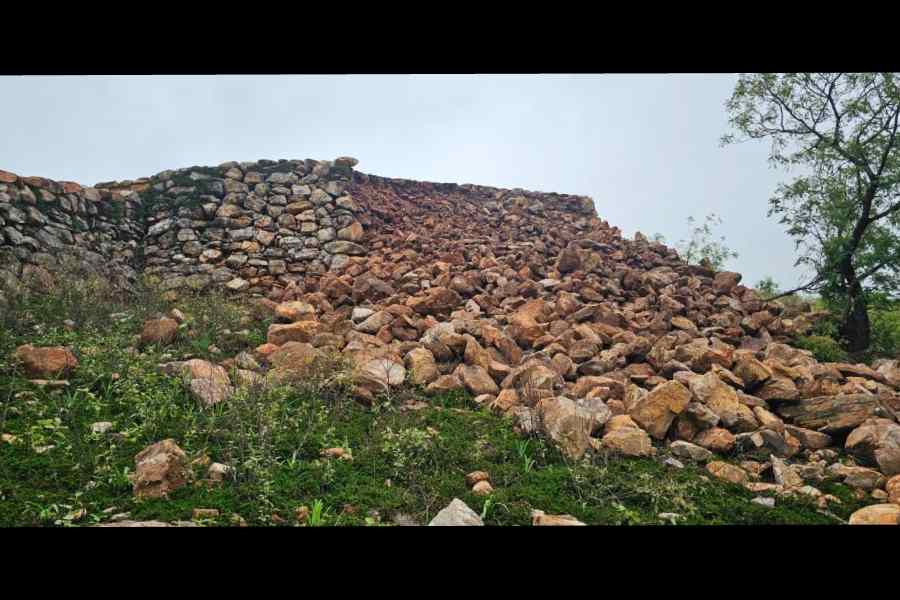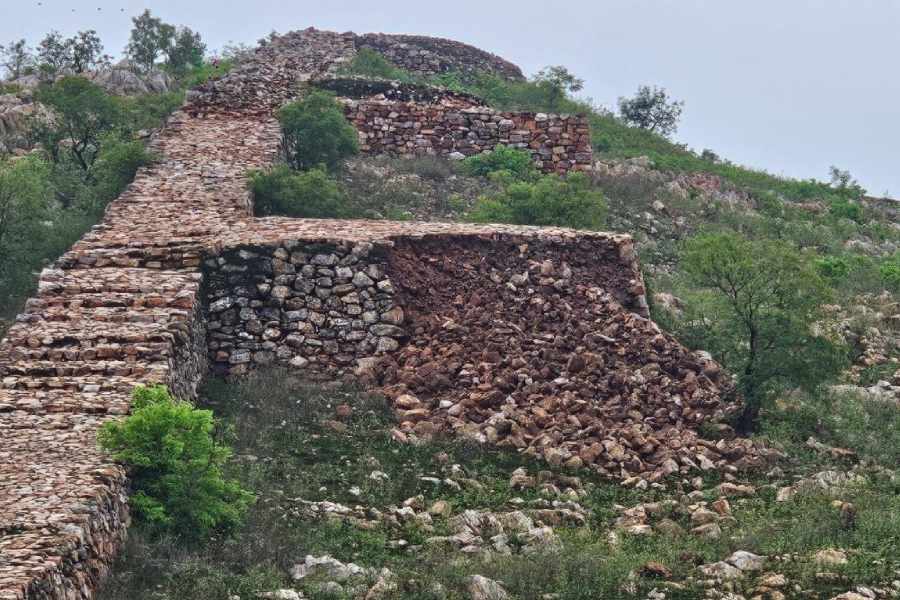Portions of the country’s oldest Cyclopean Wall in Rajgir have collapsed following heavy rain in Bihar, raising a question mark on the upkeep of the 2,600-year-old structure that was being considered for inclusion in Unesco’s World Heritage List.
Two sections of the wall, including a 20-foot long and 12-foot wide portion, crumbled near Banganga last Friday following heavy downpour in Nalanda. A team from the Archaeological Survey of India (ASI) visited the spot on Monday after the rain stopped.
“The Cyclopean Wall has subsided at two places. There has been incessant rain in the area. People living in the villages there also pointed to a lightning strike in the vicinity,” an ASI official told The Telegraph.
“We will assess the damage, prepare an estimate and repair the invaluable structure as soon as possible. The smaller portion of the wall could have collapsed after a few stones were removed,” the ASI official added.
Calls and messages to the ASI’s Patna circle superintendent, Goutami Bhattacharya, did not elicit any response.
Built around 2,600 years ago, the Cyclopean Wall is considered among the world’s oldest protective masonry or stone fortifications and predates the Great Wall of China. It is built of undressed and semi-dressed stones without any mortar.
The 45km wall with height varying from 3ft to 15ft and width between 12ft and 14ft ran across the hills and encircled Rajgriha (Rajgir), the capital of the ancient Magadh Empire, to protect it from invasions. According to Buddhist texts, the fortification had at least 24 gates with bastions and watchtowers.
Soldiers patrolled the wall around the clock. There were small alcoves or recesses on the inner side of the wall to shield security personnel from rain and sun.
The wall survived the vagaries of weather and came under the protection of the ASI around 1905. It underwent a major repair in 1944 under the supervision of the then ASI director-general, Mortimer Wheeler, and a few smaller ones over the years.
“This is the oldest example of defence architecture. It is amazing because it was constructed with the help of stones weighing just a few kilograms to up to one tonne. It protected the entire city and its inhabitants, not just the rulers. The number of stones used in the structure indicates the knowledge of stone mining prevalent at that time,” Shanker Sharma, a professor of ancient Indian history at Magadh University and a former ASI officer, told The Telegraph.
Sharma said there were similar structures in Europe and South America, some of which may predate the Cyclopean Wall in Rajgir, but none was as massive, extensive and well thought out in construction.
The Rajgir structure derives its name from cyclopean masonry, a construction technique where enormous blocks of stone are used without mortar.

A collapsed portion of the Cyclopean Wall after rain in Rajgir Sourced by The Telegraph
Such structures are found in Crete, Tiryns, Delphi, Attica and other places in Greece, Ireland, Italy, Machu Picchu (Peru) and some places in South America.
The Cyclopean Wall of Rajgir is considered similar to the “Frontiers of the Roman Empire” or the “Roman Limes”, which was built in the 2nd century AD and ran across present-day Germany, the UK and Northern Ireland. It was included in Unesco’s World Heritage List in 1987. It stretched around 5,000km from the Atlantic coast in Africa to northern Britain and up to the Black Sea in Europe. It comprised walls, ditches, forts, fortresses, watchtowers and settlements.
Chief minister Nitish Kumar has been urging the Centre since 2017 to get the Cyclopean Wall included in the Unesco World Heritage List.
The state art, culture and youth department had in 2019 sent a proposal along with historical facts on the Cyclopean Wall to the ASI. It was amended in the light of an ASI letter to the state government on March 23, 2021, and resent to the ASI director (world heritage) on March 27, 2021. The ball is now in the ASI’s court.
The condition of the wall has deteriorated over the past several years. It has been broken and vandalised in several places. A temple dedicated to Lord Ganesh has come up on what used to be a watchtower of the ancient fortification.
Gurdwara Nanak Sheetal Kund was built close to the wall in violation of the Ancient Monuments and Archaeological Sites and Remains Act, 1958. The Act designates a “prohibited area” of up to 100 metres from the protected monuments where no construction is allowed.
“There are several issues pertaining to the conservation of the Rajgir Cyclopean Wall. We are facing a resource and manpower crunch. It maintains the easily visible portions of the wall but neglects the sections that are located out of sight or in forested areas. Bushes and trees have grown at several places on the massive wall, weakening its structure,” a senior ASI official told this newspaper.
“The state forest department also creates obstacles in the maintenance of the wall by objecting when our men try to clear the bushes and trees growing close to the structure. It also sprinkled seeds all over the hills, many of which fell on the wall, germinated and grew. This was a very foolish practice to be adopted in an area that is full of ancient monuments,” the ASI official added.
Nalanda divisional forest officer Vikas Ahlawat did not pick up the call from this newspaper.










